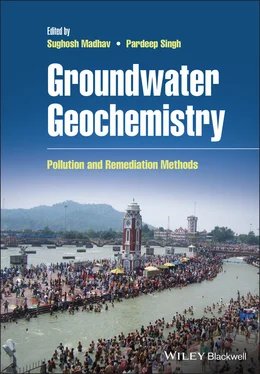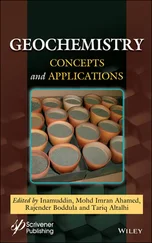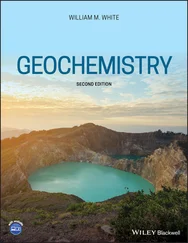1 Geogenic Pollutants in Groundwater and Their Removal Techniques
Jyoti Kushawaha and Deeksha Aithani
School of Environmental Sciences, Jawaharlal Nehru University, New Delhi, India
Water resources are one of the essential resources of nature. Being fluid, water’s nature allows it to flow into the low‐pressure zone from the high pressure. On the surface, it is found in the geographical form of rivers and streams, and it flows with varying pace depending on the gravity, pressure, and geography of the area. The contact time of water with its geographical space is lower due to pace in surface water flow, and this is the reason it has far fewer or negligible geogenic contaminants compared to anthropogenic contaminants. In contrast, the subsurface water moves at a very slow pace (a few millimetres a day) through the pore spaces or cracks of the soil and rocks. Sometimes the water becomes stagnant, like in perched aquifers and in the impermeable hard rock terrains. This very low movement of aquifer waters (groundwater) allows more time for water to interact with the surrounding natural environment, which may be hard rock, soft rock, or soil and enriched with the geogenic constituents. The groundwater contamination largely depends on the soil geochemistry through which water travelled before reaching the aquifers (Achary 2014a). Hydrological processes are important in governing groundwater contamination. Minerals mobilize in the aquifer system in response to the constituents and minerals present in the rock matrix and their depositional history, along with geochemical conditions (Garduño et al. 2011).
Approximately 1.5 billion people are dependent on underground sources of water (Mukherjee et al. 2012); this is why geogenic pollution has become a major threat to groundwater contamination. Groundwater contaminated by the rock–water interaction has resulted in geologically induced constituents such as As, F, Fe, Mn, Se, Cr, etc. Long‐term intake of F‐contaminated groundwater leads to severe fluorosis, both dental and skeletal, as well as a range of non‐skeletal effects. As‐contaminated water caused severe health effects such as arsenicosis, skin cancer, respiratory problems, and other cancers. The commonly used remedial techniques for the removal of As and F from groundwater are membrane separation, ion exchange resins, coagulation‐precipitation (also known as Nalgonda technique), and adsorption filter beds. It is essential to understand the operational parameters before adopting these potential techniques for remediation such as the local water demand, water quality parameters, initial concentration, and daily basis water use patterns. As‐contamination is highest in the Indo‐Gangetic plain in the eastern and northeastern parts of India.
Geogenic contaminants, including arsenic, fluoride, and iron are commonly observed in nature. In India, the foremost geogenic contamination in aquifers is Arsenic and Fluoride (Garduño et al. 2011). Other contaminants include nitrate, phosphate, heavy metals and trace metals which may result of the human activities including domestic savage, septic tank, industrial effluents and agricultural practises (Madhav et al. 2018). In India, there are several states and districts which are affected by geogenic contamination such as Arsenic (10 states and 68 districts), Fluoride (20 states and 276 districts), and Iron (24 states and 294 districts) (CGWB 2014).
Arsenic is overarching with a variable amount in the Earth's crust, mostly in the form of arsenate and arsenite (WHO 2011). In water, generally, it is present as arsenate (As V) in oxidizing condition and as arsenite (As III) form in reducing condition. The fresh biomass, rainfall infringement in the recent alluvium may be the reason for the evacuation of As and Fe from the sediments or soils (Aulakh et al. 2009; Raju et al. 2012). It is introduced in water via different sources such as the dissolution of minerals, rocks, and soil, mining activity (mining waste), mineral smelting, coal combustion, industrial effluents, and through the dry and wet deposition of atmosphere's dust. It is used commercially as the alloy in the formation of semiconductors and in other electricals. Moreover, it used as a preservative for wood, and industrially in the textile, paper, and glass industries for processing. It is also used in pharmaceuticals, food additives, and pesticides to a small extent. The average concentration ranged from 1–2 mg/kg in the continental crust, in which 1.5–3.0 mg/kg was in igneous rock followed by 1.7–400 mg/kg in sedimentary (CGWB 2014).
Arsenic contamination is distinguished in important basin river basins of India, the Ganga and Brahmaputra river basins. These two rivers originated from the Himalayas and create the two significant river basins of India. The As contaminants are prevalent in the lowland area rich with either organic or clayey deltaic sediments in the Bengal basin, as well as sites of the entrenched river channels having the similar facies but sometimes in small pockets in the middle Ganga plain (MGP), i.e. Uttar Pradesh, Bihar, Jharkhand, and West Bengal (Chakraborti et al. 2002; Raju et al. 2012; Saha and Sahu 2016; Tirkey et al. 2017; Kumar et al. 2019). Arsenic induced groundwater deterioration in MGP to the lower Ganga Plain including Uttar Pradesh, Bihar, Jharkhand, and West Bengal and consistently created an adverse impact on human health.
Arsenic is more concentrated in the alluvial aquifers, small lenses in the MGP, low‐lying basin of Bengal, and localized contamination through the gneissic aquifers in Chhattisgarh. Geographically, the large area comes under arsenic contamination from the 89 blocks and 57 blocks in West Bengal and Bihar, respectively. Arsenic contamination is also pervasive sequentially in Uttar Pradesh, Jharkhand, Haryana, Punjab, Manipur, and Assam (Aulakh et al. 2009; Saha and Sahu 2016; Lapworth et al. 2017; Tirkey et al. 2017; Kumar et al. 2019). Most of the cases were reported from the younger alluvial aquifer systems (CGWB 2014).
As poses more adverse health impact to human than animals due to different gastrointestinal absorption. The consumption of As‐contaminated water damages human health, including respiratory distress resulting into laryngitis, bronchitis, or rhinitis, cardiovascular effects, and gastrointestinal effects like lips burning, pain while swallowing, abdominal pain, thirst, and nausea. Consumption of the inorganic As increases the risk of lung cancer, including the side effects of it such as headache, lethargy, hallucination, keratosis and hyperpigmentation in skins, seizures, and mental confusion (Mandal et al. 1996; CGWB 2014).
The organic and inorganic arsenic compound has been introduced in the water system through geological and anthropogenic sources. It is available in all geological material in variable concentration. Arsenic mobilization depends on three mechanisms in groundwater, which have been proposed:
1 Oxidation of arsenic‐bearing pyrite minerals.FeAsS +13Fe3+ + 8H2O → 14Fe2+ + SO42‐ + 13H+ + H3AsO4(aq)
2 Dissolution of As‐rich iron oxyhydroxides (FeOOH) under reducing conditions:8FeOOH‐As(s) + CH3COOH + 14H2CO3 → 8Fe2+ + As(d)+ + 16HCO3− + 12H2O
3 Release of As present in the aquifer media exchanged with phosphate (H2PO−) linked with percolation of phosphate ions into the aquifer when excess application is done in farming practices (Acharya et al. 1999; Pokhrel et al. 2009).
The dissolution of FeOOH under reducing conditions reflected the possible reason for the elevated concentration of arsenic in subsurface water (Harvey et al. 2002). Apart from these, arsenic shows a strong affinity for protein; the biological sources also contribute arsenic though the soil and water ecosystem. Arsenic exhibits a strong affinity for proteins, lipids, and other cellular components and as such, accumulates readily in living tissues (Ferguson and Gavis 1972). Besides this, arsenic concentration was observed high in the aquatic organism through the processes of biomagnification.
Читать дальше




